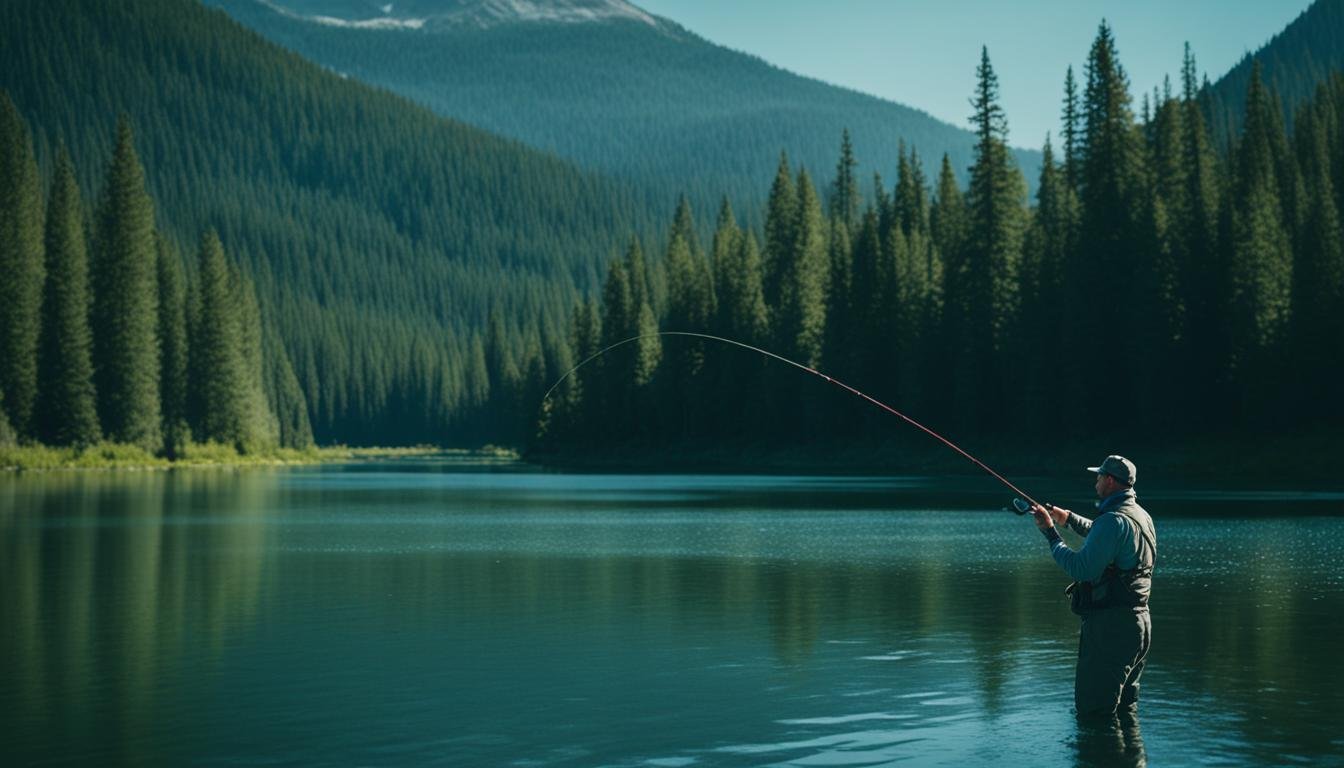Canada’s vast and diverse fishing landscape offers anglers a world-class experience like no other.
With over 150,000 miles of coastline, the longest in the world, and countless rivers, lakes, and streams teeming with a wide array of fish species, the fishing opportunities north of the border are truly unparalleled.
But what are the top techniques that seasoned anglers use to make the most of this fishing paradise?
Prepare to unlock the secrets of Canada’s best fishing techniques and get ready to embark on an unforgettable angling adventure.
Key Takeaways about Canada’s Best Fishing Techniques
- Discover the diverse range of fishing opportunities across Canada’s coastal, freshwater, and ice fishing environments.
- Explore the most effective techniques for targeting popular species like trout, salmon, walleye, and more.
- Learn about the best times of year to fish for specific species and how to tailor your approach accordingly.
- Understand the importance of choosing the right fishing gear and tackle to maximize your success on the water.
- Familiarize yourself with the necessary fishing licenses and regulations to ensure a safe and legal fishing experience in Canada.
Introduction to Fishing in Canada
Canada’s vast and diverse waters offer a true angler’s paradise. From the Atlantic and Pacific coasts to the countless rivers, lakes, and streams that dot the country, Canadian waters teem with a wide variety of fish species, including trout, salmon, bass, walleye, muskellunge, pike, perch, and even the majestic sturgeon. The sheer scale and diversity of Canada’s fisheries make it a premier destination for anglers of all skill levels, each seeking their own unique fishing experience.
The Diversity of Canadian Waters
Canada’s fishing opportunities are as diverse as the landscapes that define the country. Anglers can explore the rugged coastlines of the Atlantic and Pacific oceans, casting for species like rockfish, lingcod, and halibut. Inland, the countless lakes, rivers, and streams of the Canadian Shield and Prairies offer excellent freshwater fishing for trout, salmon, bass, walleye, and more. From the remote northern reaches to the bustling urban centers, Canada’s waters are a true natural wonder waiting to be discovered by passionate anglers.
Popular Fish Species to Target
- Trout – Canada is renowned for its excellent trout fishing, with species like rainbow, brook, and brown trout found in rivers and lakes across the country.
- Salmon – The Pacific Northwest is home to world-class salmon fisheries, with species like Chinook, coho, and sockeye drawing anglers from around the globe.
- Bass – Largemouth and smallmouth bass thrive in many of Canada’s southern lakes and rivers, providing thrilling catch-and-release experiences.
- Walleye – The iconic walleye is a staple of many Canadian fisheries, with excellent populations in the Great Lakes region and across the Prairie provinces.
- Muskellunge – The elusive “muskie” is a highly sought-after trophy fish, with renowned fisheries in Ontario, Quebec, and Manitoba.
- Pike – Northern pike are abundant in Canada’s northern lakes and rivers, offering hard-fighting action for anglers.
- Perch – Yellow perch are a popular target for both open-water and ice anglers, providing excellent table fare.
- Sturgeon – The prehistoric sturgeon can reach massive proportions in Canada’s Pacific and Fraser River systems.
Whether you’re seeking the thrill of battling a powerful salmon, the finesse of fly fishing for trout, or the excitement of landing a trophy pike or muskellunge, Canada’s diverse fisheries offer unparalleled opportunities for anglers of all interests and skill levels.
Freshwater Fishing Techniques
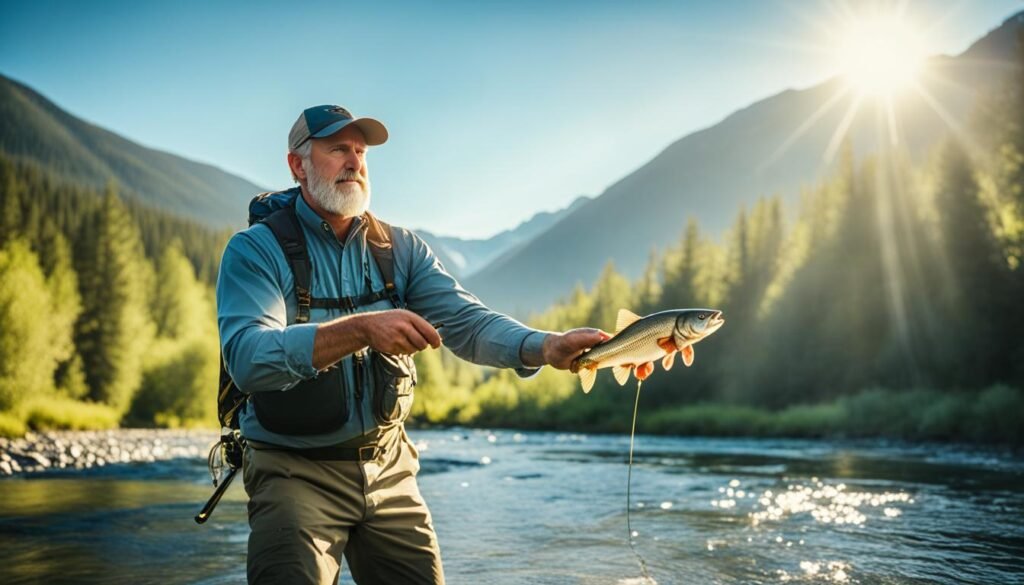
Canada’s vast and diverse freshwater ecosystems offer anglers a wealth of opportunities to explore different fishing techniques. Two of the most popular and productive methods for targeting the country’s prized game fish are fly fishing and bait fishing.
Fly Fishing for Trout and Salmon
Fly fishing is a revered and challenging pursuit, particularly when it comes to pursuing the mighty trout and salmon that thrive in Canada’s rivers and streams. These agile, hard-fighting fish are known to put up a spirited battle, testing the skills of even the most experienced fly anglers.
To succeed with fly fishing, anglers must master the delicate art of casting and presenting their flies in a natural, drag-free manner. The selection of the right fly pattern, based on the prevailing hatch or forage, is also crucial for enticing strikes from these discerning fish.
“Fly fishing for trout and salmon is a true test of an angler’s skill and patience. The reward of landing one of these magnificent fish on a fly makes the effort well worth it.” – Experienced Canadian fly fishing guide
Bait Fishing for Bass and Walleye
While fly fishing attracts many anglers, bait fishing remains a highly effective and popular technique for targeting species like bass and walleye. These hard-fighting game fish are found in abundance in Canada’s lakes and rivers, and bait fishing offers a more straightforward approach for those new to the sport or seeking a more relaxed angling experience.
Anglers can use a variety of live and natural baits, such as worms, minnows, and leeches, to entice bass and walleye to strike. Presentation and proper rigging are key, as is understanding the behavior and habitat preferences of these species to locate the most productive fishing spots.
Whether you prefer the finesse of fly fishing or the simplicity of bait fishing, Canada’s freshwater fisheries offer an unparalleled array of opportunities for anglers to hone their skills and enjoy the thrill of the catch.
Ice Fishing in Canada
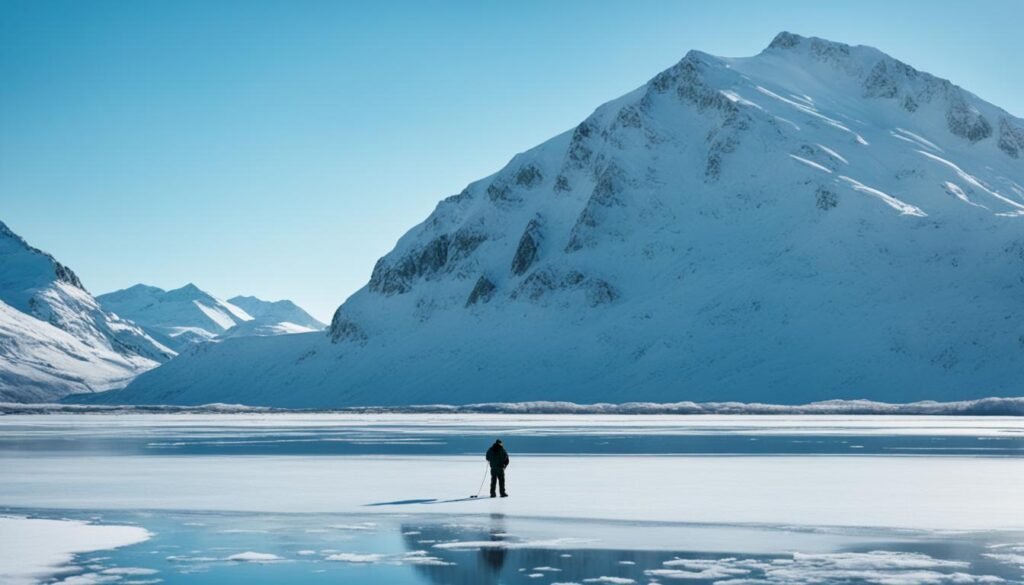
Canada’s long, cold winters offer excellent opportunities for ice fishing, with anglers targeting species like pike, perch, and walleye through the frozen lake and river surfaces. Ice fishing techniques can be highly effective, and the unique experience of fishing on the ice is a must-try for those visiting Canada during the winter months.
Ice-over for ice fishing in Ontario usually occurs in early November, but in some years, it can delay until December. Safety is paramount, and experts recommend waiting for at least 6 inches of ice thickness before venturing out to fish. To create a comfortable fishing experience, many anglers use ice shacks equipped with propane heaters and lights.
Successful ice fishing tactics often involve using 1/8 oz. lead head jigs with live minnows for walleye fishing. Anglers typically use 20-inch medium or light-action ice fishing rods with 6-8 pound test lines. The key is to jig the bait close to the lake floor and set the hook with a slight tension.
| Ice Fishing Equipment | Recommended Specifications |
|---|---|
| Ice Fishing Rods | 20-inch medium or light-action, 6-8 pound test lines |
| Jigs | 1/8 oz. lead head jigs with live minnows |
| Ice Auger | 8-inch auger can accommodate a variety of fish sizes |
Ice fishing in Canada has evolved with the use of modern equipment such as portable huts, warm flotation suits, lightweight ice augers, fishfinders, hand-held GPS units, ATVs, and snowmobiles. Professional anglers often use a variety of rods, with half a dozen rods of different actions and lengths recommended for ice fishing.
“Ice fishing is an all-age group activity that promotes bonding among family and friends.”
Northwestern Ontario offers abundant ice fishing opportunities, and it is a popular winter outdoor activity alternative to summer fishing. Ice fishing success is often associated with anglers who make an effort to fish as often as possible, as consistency is key.
Modern ice fishing techniques also involve the use of innovative equipment like the Beaver Dam Original Tip-Up, Pro Thermal Tip-Up, and Jaw Jacker Hook Setter. These tools can enhance the ice fishing experience by improving efficiency and convenience.
Whether you’re a seasoned angler or a newcomer to the sport, ice fishing in Canada is a unique and rewarding experience that offers the chance to connect with the great outdoors and catch a variety of fish species during the winter months.
Salmon Fishing Techniques
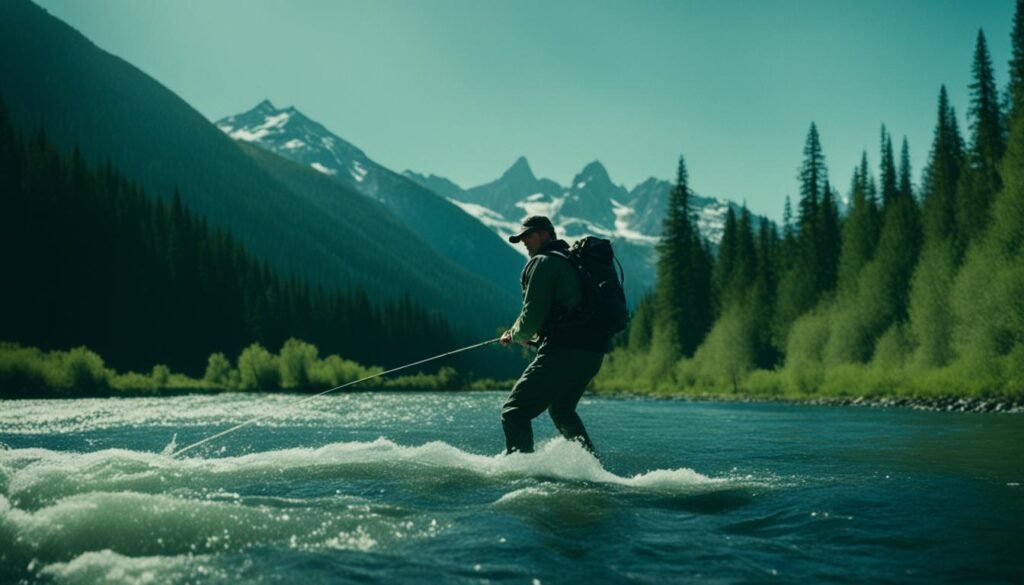
Salmon fishing is a quintessential Canadian angling experience, with six distinct species available across the country. From the mighty chinook to the acrobatic coho and the vibrant sockeye, these impressive fish present a thrilling challenge for anglers. Among the most popular techniques for targeting salmon are trolling, mooching, and bucktailing, each offering unique advantages and requiring specialized skills.
Trolling for Salmon
Trolling is a widespread and effective method for catching salmon, particularly the larger chinook and coho varieties. The technique involves slowly pulling artificial lures or bait through the water while the boat maintains a steady forward motion.
Anglers can optimize their trolling setup by using the right combination of lures, bait, and electronics to locate and entice the salmon. Roe bait, soft plastic beads, and Colorado blades are just a few of the proven producers when trolling for salmon in Canadian waters.
Mooching and Bucktailing
In addition to trolling, mooching and bucktailing are two other popular salmon fishing techniques. Mooching involves drifting or slowly motoring while presenting bait, often roe or herring, on a weighted line. This method allows anglers to target salmon holding in specific lies or travel corridors.
Bucktailing, on the other hand, utilizes a weighted jig or spoon with a trailing feather or hair skirt, which is vertically jigged or cast and retrieved to tempt salmon. Jigs in colors like pink, red, and orange are particularly effective for this technique.
Regardless of the method employed, successful salmon fishing in Canada requires an understanding of fish behavior, the use of specialized gear, and a keen eye for finding the right spots. By mastering these techniques, anglers can increase their chances of landing one of these magnificent fish and creating unforgettable memories on the water.
| Salmon Species | Key Characteristics |
|---|---|
| Chinook Salmon | The largest of the Pacific salmon, with a potential to grow over 10 pounds in just 4 years. |
| Coho Salmon | Known for their impressive acrobatic jumps and fights, coho salmon are a highly sought-after gamefish. |
| Sockeye Salmon | Recognized for their vibrant red bodies and green heads during spawning, sockeye salmon are a prized catch. |
| Pink Salmon | The smallest of the Pacific salmon species, pinks are renowned for their abundance and accessibility. |
| Chum Salmon | Widely distributed across the North Pacific, chum salmon offer a challenging but rewarding fishing experience. |
“Salmon fishing in Canada is a true test of an angler’s skill, patience, and determination. The sheer power and beauty of these fish make every catch a thrilling accomplishment.”
Top Fishing Techniques for Canada
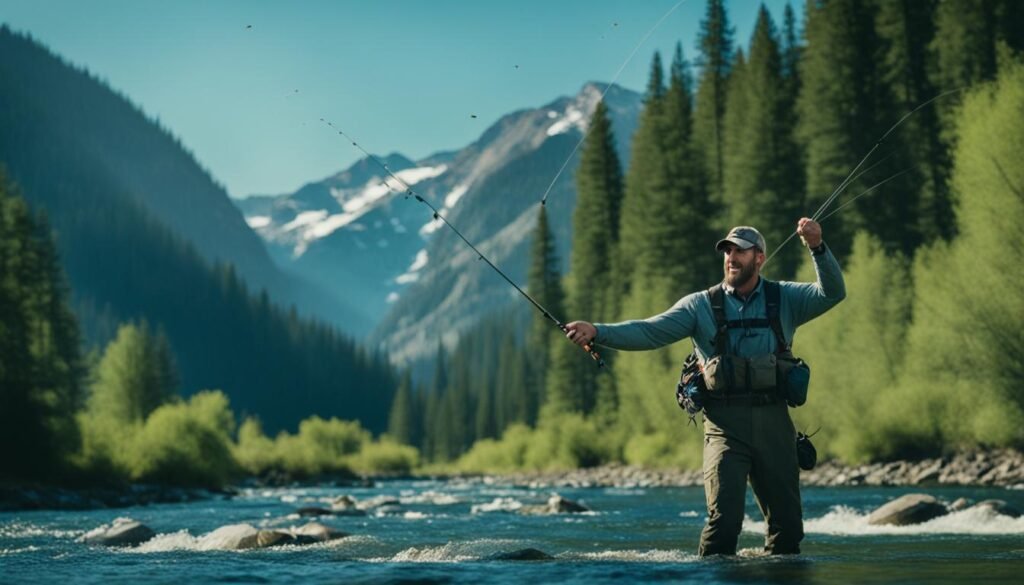
Canada is blessed with a diverse array of fishing opportunities, offering anglers the chance to explore a range of techniques and target a wide variety of fish species. Whether you prefer the finesse of fly fishing, the thrill of bait fishing, the challenge of ice fishing, or the versatility of spin fishing, there’s a technique to suit every angling enthusiast in the Great White North.
Fly Fishing for Trout and Salmon
Fly fishing is a beloved pastime among Canadian anglers, particularly when targeting trout and salmon in the country’s pristine rivers and streams. This delicate technique requires specialized equipment and a keen understanding of the local hatch patterns and fish behavior. By presenting a carefully crafted artificial fly on a lightweight rod and line, fly fishermen can entice these magnificent game fish to strike, providing an exhilarating and rewarding experience.
Bait Fishing for Bass and Walleye
For anglers seeking the excitement of landing hard-fighting freshwater species, bait fishing for bass and walleye is a top choice. By using live or natural baits like minnows, worms, or leeches, anglers can target these aggressive predators in a variety of water bodies, from lakes and rivers to reservoirs and ponds. The thrill of the strike and the challenge of setting the hook make bait fishing a versatile and rewarding technique.
Ice Fishing for Trophy Pike and Trout
Canada’s cold climate offers a unique opportunity for ice fishing, a method that allows anglers to access the bounty of frozen lakes and rivers. By drilling holes in the ice and using specialized equipment like ice augers, tip-ups, and jigging rods, anglers can target trophy-sized pike, lake trout, and other cold-water species. Ice fishing requires careful consideration of safety, with proper gear and knowledge of ice conditions being essential for a successful and enjoyable experience.
Spin Fishing for Versatility
Spin fishing is a highly versatile technique that can be employed in a wide range of Canadian waters, from shallow streams to deep lakes. By using spinning reels and lures or bait, anglers can target a variety of fish species, including walleye, bass, trout, and even the mighty muskie. Spin fishing is a great option for beginners and experienced anglers alike, offering the opportunity to cover water efficiently and adapt to changing conditions.
Trolling for Salmon
For anglers seeking the thrill of chasing anadromous fish like salmon, trolling is a highly effective technique. By slowly dragging lures or bait through the water using a boat or canoe, anglers can cover large areas and intercept the migrations of these powerful fish. Trolling requires patience and precision, but the reward of hooking a hard-fighting salmon is well worth the effort.
Regardless of the fishing technique you choose, it’s essential to practice responsible catch-and-release methods to ensure the sustainability of Canada’s incredible fisheries. By using the right tackle, handling fish with care, and minimizing the time out of the water, anglers can enjoy the sport while contributing to the long-term conservation of these valuable resources.
| Fishing Technique | Target Species | Optimal Conditions | Key Considerations |
|---|---|---|---|
| Fly Fishing | Trout, Salmon | Warm, clear waters | Specialized equipment and skill required |
| Bait Fishing | Bass, Walleye | Varied water bodies | Appealing to the fish’s natural feeding behavior |
| Ice Fishing | Pike, Trout | Frozen lakes and rivers | Ensuring ice safety and using specialized equipment |
| Spin Fishing | Walleye, Bass, Trout, Muskie | Diverse water conditions | Versatility and adaptability to changing situations |
| Trolling | Salmon | Areas with migratory fish runs | Patience and precision in covering large areas |
By understanding the unique characteristics and advantages of each top fishing technique, anglers in Canada can tailor their approach to the specific conditions, target species, and personal preferences. Whether you’re a seasoned pro or a passionate newcomer, there’s an abundance of opportunities to explore the diverse fishing landscape of this remarkable country.
Saltwater Fishing Techniques
Canada’s vast coastlines on the Atlantic and Pacific oceans offer anglers a wealth of saltwater fishing opportunities. Techniques like jigging for rockfish and lingcod, as well as specific methods for targeting the mighty halibut, are the focus of this section.
Rockfish and Lingcod Jigging
Jigging is a popular and effective technique for catching rockfish and lingcod in Canada’s coastal waters. This method involves using a specialized lure-like jig that is raised and lowered vertically through the water column to attract and entice these hard-fighting bottom-dwelling species. Anglers can employ various jigging machines, both electric and hydraulic, to automate the jigging motion and increase efficiency.
When jigging for rockfish and lingcod, it’s important to target areas with structure, such as underwater reefs, ledges, and drop-offs, where these species tend to congregate. Maintaining a consistent jigging rhythm and keeping the lure near the bottom is key to success.
Halibut Fishing Methods
The massive halibut is another prized saltwater species found in Canada’s coastal waters. Anglers have developed specialized techniques to target these impressive flatfish. One popular method is longlining, which involves setting a long fishing line with hundreds of baited hooks to increase the chances of a successful catch.
Alternatively, some anglers prefer the more traditional hook-and-line fishing approach, which can yield exceptional halibut of premium quality. The hook-and-line method allows for more selective fishing, ensuring the catch is of the highest caliber.
Regardless of the technique used, halibut fishing often requires heavy tackle and a sturdy boat to handle the size and strength of these remarkable saltwater predators.
Whether you’re jigging for rockfish and lingcod or targeting the mighty halibut, Canada’s coastal waters offer an array of exciting saltwater fishing experiences. By mastering these specialized techniques, anglers can unlock the full potential of the country’s bountiful marine resources.
Fishing Seasons in Canada
Anglers planning a fishing trip to Canada must be aware of the highly seasonal nature of the sport. Different fish species and optimal techniques ebb and flow throughout the year, offering unique opportunities during each season. By understanding the seasonal patterns, you can maximize your chances of catching your desired quarry and enjoy a successful Canadian fishing adventure.
Spring and Summer Fishing
The early fishing season in Northern Canada typically begins towards the end of May and continues through June, as the ice starts to melt. This is an excellent time for targeting trout, with Lake Trout preferring the cold waters around 10°C (50°F). Guests have reported catching over 100 fish in a day during the peak summer months of July and August, despite June being favored by many for the sheer number of fish caught.
The weather during the spring and summer months is generally mild, with average lows around 10°C (50°F) and highs around 25°C (77°F) in June, and slightly warmer temperatures in July ranging from 12°C (53°F) to 27°C (81°F).
Fall and Winter Fishing
As the air starts to cool in the fall, the fishing opportunities shift. September temperatures, with average lows of 8°C (47°F) and highs of 21°C (70°F), provide excellent conditions for Lake Trout and Northern Pike as they move to shallower waters to feed before spawning. The fall fishing season, marked by cooler temperatures that can drop below 10°C, offers a diverse range of freshwater species, including Lake Trout, Salmon, Northern Pike, and Walleye.
As winter approaches, the fishing shifts to the ice-covered lakes and rivers, with specialized techniques like ice fishing becoming the focus. The article provides valuable insights into the best fishing spots, techniques, and local knowledge that can be obtained from the expertise of experienced guides at Arctic Lodges.
“An average temperature of 18°C during a summer morning is reported as the ideal condition for catching 30+ pound pike and other big fish.”
Fishing Gear and Tackle Recommendations
Selecting the right fishing gear and tackle is crucial for success in Canada’s diverse waters. From rods and reels to lures and bait, the essential equipment can make or break your angling experience. In this section, we’ll provide recommendations on the optimal gear to help you make the most of your Canadian fishing adventures.
Rods and Reels
Rods and reels are the foundation of any fishing setup. Popular reel types in Canada include spincasting and spinning reels. Spincasting reels are suitable for fish up to 10 pounds, offering durability and ease of use, while spinning reels are highly versatile, durable, and allow for accurate long-distance casts. For beginners, a medium-action rod is recommended for its flexibility and versatility.
When it comes to fishing line, the strength is measured in “pounds test.” Recommended line strengths for popular game fish in Canada include:
- Rainbow Trout: 6-10 lb test
- Brook Trout: 2-6 lb test
- Lake Trout: 6-10 lb test
- Walleye: 6-8 lb test
Heavier lines are generally recommended for fishing in areas with heavy weeds, rocks, logs, or stumps, while lighter lines are preferable in clear waters.
Lures and Bait
Lures come in a variety of categories based on the depth they are intended to be fished at, such as surface lures, shallow-water lures, and deep-water lures. Some popular lure options include jigs, spoons, Rapalas, and Storm Hot n’ Tots, each designed to target specific fish species and fishing conditions.
While live bait can be effective, using unbaited lures is recommended to help maintain healthy fish populations. When using bait, be sure to check regulations and restrictions on bringing live bait into Canada.
Essential Gear and Accessories
In addition to your rods, reels, and tackle, it’s important to have the right accessories and gear for a successful fishing trip. Recommended items include:
- Needle-nose pliers
- Nail clippers
- Sharp fillet knife
- Sunscreen
- Insect repellent
- Emergency Boat Kit (50′ rope, whistle, flashlight, bailing bucket)
- Passport, fishing license, and other required documents
- Appropriate clothing and footwear for the weather
By equipping yourself with the right fishing gear and tackle, you’ll be well on your way to enjoying an unforgettable angling experience in Canada’s diverse waters.
Fishing Licenses and Regulations
Fishing in Canada is heavily regulated to ensure the sustainability of the country’s valuable fisheries. Anglers must be aware of the fishing license requirements and important regulations before planning their angling adventures. Respecting and adhering to these guidelines is not only a legal obligation but also a crucial part of responsible fishing and conservation efforts in Canada.
In Ontario, there are two main types of recreational fishing licenses: the Sport Fishing License and the Conservation Fishing License. These licenses are available to both residents and non-residents, and they dictate the specific rules and limits that anglers must follow.
Interestingly, Canadian and Ontario residents are provided with four opportunities throughout the year to fish without having to purchase a fishing license. These occasions include the Family Fishing Weekend, Mother’s Day Weekend, Father’s Day Weekend, and Ontario Family Fishing Week.
It is important to note that the delivery time for an Outdoors Card, which is required to obtain a fishing license, is approximately 20 days. Additionally, regardless of the date of purchase, 1-year fishing licenses expire on December 31 of the year printed on the license, while 3-year fishing licenses expire on December 31 of their third year.
Ontario is divided into 20 Fisheries Management Zones (FMZs), each with its own set of regulations, including seasonal restrictions, catch limits, and size limits for popular fish species. Anglers must familiarize themselves with the specific regulations for the FMZ they plan to fish in.
| Regulation Highlights | Description |
|---|---|
| Aggregate Limits | Certain combinations of fish species, such as walleye and sauger, largemouth and smallmouth bass, and black and white crappie, have aggregate limits. |
| Catch and Possession Limits | There are catch and possession limits for each individual angler, and any fish gifted to another person count towards the catch limit. |
| Conservation Officers | Conservation officers in Ontario enforce fisheries regulations and have powers of inspection, search and seizure, arrest, and other actions. |
| Invasive Species | Invasive species, such as round gobies, caught must not be released back into the environment. |
| Bait Regulations | Anglers must obtain bait from the designated bait management zone where they are fishing and dispose of any unused bait or substrate properly. |
Fishing in Canada is not only about the thrill of the catch but also about respecting the regulations and contributing to the conservation of the fisheries. By understanding and adhering to the fishing licenses and regulations, anglers can ensure a sustainable and enjoyable fishing experience in Canada.
Conclusion
Canada’s unparalleled Canada fishing opportunities make it a premier destination for anglers from around the world. From the vast freshwater lakes and rivers to the productive saltwater coasts, this comprehensive guide has explored the top fishing techniques, target species, and essential information to help you make the most of your Canadian fishing experience. With the right knowledge and preparation, anglers can unlock the incredible fishing potential that Canada has to offer.
This overview has provided a wealth of insights into the diverse range of fishing methods, from the timeless art of bait fishing to the technical mastery of fly-fishing and trolling. Whether you’re pursuing trophy-sized trout, feisty bass, or the legendary Pacific salmon, Canada’s waters offer an unparalleled angling experience for anglers of all skill levels.
As you plan your next Canada fishing adventure, remember to stay informed about the latest regulations, purchase the necessary licenses, and equip yourself with the right gear. With a deep respect for the environment and a commitment to sustainable practices, anglers can enjoy the wonders of Canada’s fisheries for generations to come. So pack your tackle, grab your rod, and get ready to embark on an unforgettable fishing journey in this remarkable country.
FAQ about Canada’s Best Fishing Techniques
What are the top fishing techniques for anglers in Canada?
The top fishing techniques for anglers in Canada include fly fishing, bait fishing, ice fishing, spin fishing, and trolling. These methods allow anglers to target a diverse array of fish species, from trout and salmon to bass, walleye, and even massive sturgeon.
What are the most popular fish species to target in Canada?
Some of the most popular fish species to target in Canada include trout, salmon, bass, walleye, muskellunge, pike, perch, and sturgeon. The country’s vast and diverse waters offer excellent opportunities for anglers to pursue these prized game fish.
What are the best techniques for fly fishing in Canada?
Fly fishing for trout and salmon is a popular and challenging pursuit in Canada. Anglers can target these prized species in the country’s numerous rivers and streams using a variety of fly fishing techniques.
What are the benefits of ice fishing in Canada?
Canada’s long, cold winters provide excellent opportunities for ice fishing, with anglers targeting species like pike, perch, and walleye through the frozen lake and river surfaces. Ice fishing techniques can be highly effective, and the unique experience of fishing on the ice is a must-try for those visiting Canada during the winter months.
What are the top techniques for salmon fishing in Canada?
Techniques like trolling, mooching, and bucktailing are widely used to target the six different species of salmon found across Canada. Each method presents unique challenges and rewards for anglers seeking these impressive fish.
What are the best saltwater fishing techniques in Canada?
Canada’s extensive coastlines on the Atlantic and Pacific oceans offer exceptional saltwater fishing opportunities. Techniques like jigging for rockfish and lingcod, as well as specific methods for targeting the massive halibut, are popular among anglers fishing the country’s coastal waters.
What are the optimal fishing seasons in Canada?
The fishing in Canada is highly seasonal, with different species and techniques peaking at various times of the year. Understanding the seasonal patterns can help anglers plan their Canadian fishing trips for maximum success.
What fishing gear and tackle are recommended for anglers in Canada?
Selecting the right fishing gear and tackle is crucial for success in Canada’s diverse waters. This includes recommendations on rods, reels, lures, and bait for the various fishing techniques and target species.
What are the key fishing license requirements and regulations in Canada?
Fishing in Canada is heavily regulated to ensure the sustainability of the country’s valuable fisheries. Anglers must be aware of the licensing requirements and important regulations to ensure they are fishing responsibly and in compliance with the law.
Source Links
- https://fishingbooker.com/blog/canada-fishing/ – Canada Fishing: The Ultimate Guide for 2024
- http://www.ontario.ca/page/learn-fish-guide – Learn to Fish – Guide
- https://northernontario.travel/fishing/spring-fling – Spring Fling
- https://bushlife.ca/fishing/ – Fishing for Beginners: Introductory Guide for the New Angler
- https://fishingbooker.com/blog/best-fishing-canada/ – Best Fishing Destinations in Canada for 2024
- https://www.destinationontario.com/en-ca/articles/fishing-for-beginners-ontario – Fishing for beginners in Ontario
- https://www.wired2fish.com/bank-fishing/shore-fishing-tips-catch-more-fish-from-the-bank – Shore Fishing Tips | Catch More Fish From the Bank
- https://smoothmovesseats.com/blog/10-essential-tips-for-successful-freshwater-fishing/ – 10 Essential Tips for Successful Freshwater Fishing
- https://www.gofishbc.com/learn/fishing-tips/lake-fishing/tips-for-shore-and-dock-fishing-success/ – Tips for Shore and Dock Fishing Success – Freshwater Fisheries Society of BC
- https://northernontario.travel/sunset-country/beginners-guide-ice-fishing-canada – A Beginners Guide to Ice Fishing in Canada
- https://www.outdoorcanada.ca/expert-ice-fishing-tips/ – 11 basic ice fishing tips • Outdoor Canada
- https://fishncanada.com/the-ultimate-guide-to-ice-fishing-tip-ups/ – The Ultimate Guide to Ice Fishing Tip-Ups – Fish’n Canada
- https://bentrods.ca/blogs/always-in-pursuit-blog/chinook-salmon-river-fishing – Chinook Salmon River Fishing
- https://www.takemefishing.org/how-to-fish/how-to-catch-fish/how-to-catch-salmon/ – How to Catch Salmon
- https://superiorcountry.ca/fishing-and-hunting/top-5-lure-presentations-for-chinook-salmon/ – Top 5 Lure Presentations for Chinook Salmon | Superior Country
- https://www.thefranklinclub.ca/the-most-popular-types-of-fishing-in-canada/ – Popular Types of Fishing in Canada | The Franklin Club
- https://www.arcticlodges.com/canada-pike-fishing/ – Tips for Northern Pike Fishing in Canada | Arctic Lodges
- https://fishncanada.com/5-shore-fishing-tips-and-techniques/ – 5 Shore Fishing Tips and Techniques You Need To Know – Fish’n Canada
- https://vanislemarina.com/news-blog/33-different-styles-of-fishing/ – 33 Different Styles of Fishing – Van Isle Marina
- https://www.cdli.ca/cod/history6.htm – Atlantic Fishing Methods
- https://www.ez-dock.com/blog/tips-for-saltwater-dock-fishing/ – Tips for Saltwater Dock Fishing – EZ Dock
- https://www.arcticlodges.com/when-is-the-best-time-to-fish-in-northern-canada/ – Best Time to Fish in Northern Canada | Arctic Lodges
- https://airtunilik.com/en/when-is-the-best-time-to-fish-in-northern-canada/ – When is the best time to fish in Northern Canada?
- https://fishingmanitoba.com/grand-slam-fishing-success-in-canada/ – Grand Slam Fishing Success in Canada: Ultimate Guide | Cobham River Lodge
- https://mywildalberta.ca/youth/go-fish-learn-how/fishing-gear.aspx – Fishing Gear | AEP – Environment and Parks
- https://www.rustymyers.com/what-to-bring – Fishing Gear Ontario | Canada Fishing Trip
- https://www.pkresort.com/tackle-guide – Tackle Guide | PK Resort Fly In Fishing Ontario Canada
- http://www.ontario.ca/document/ontario-fishing-regulations-summary/recreational-fishing-licences-and-fees – Recreational fishing licences and fees | Ontario Fishing Regulations Summary
- http://www.ontario.ca/document/ontario-fishing-regulations-summary/general-fishing-regulations – General fishing regulations | Ontario Fishing Regulations Summary
- https://www.destinationontario.com/en-ca/articles/everything-you-need-know-about-fishing-ontario – Everything you need to know about fishing in Ontario
- https://www.britannica.com/topic/fishing-recreation/Methods – Fishing – Angling, Trolling, Casting
- https://www150.statcan.gc.ca/n1/pub/16-002-x/2008002/article/10622-eng.htm – A profile of recreational fishing in Canada
- https://waves-vagues.dfo-mpo.gc.ca/Library/270416.pdf – PDF
